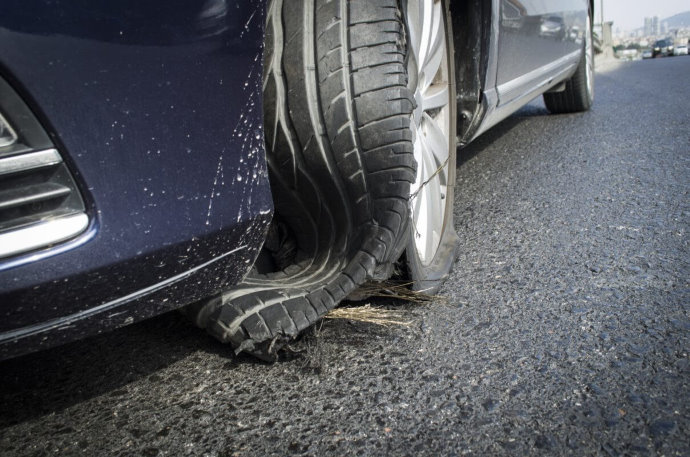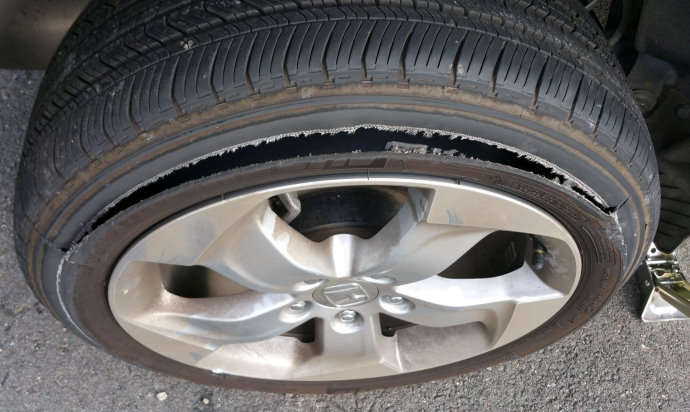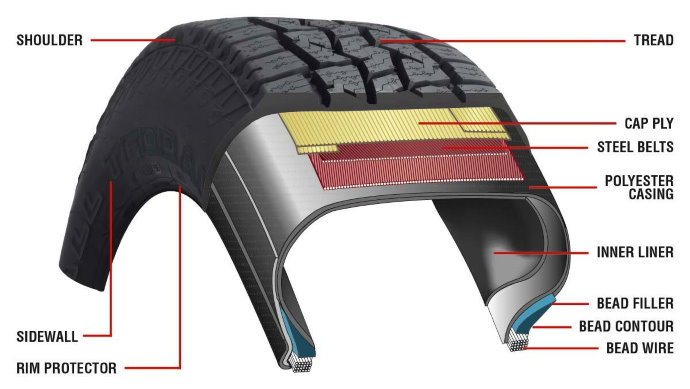 Tyre failure is often blamed as one of the leading “vehicle factors” contributing to road crashes. As a public information platform with a passionate interest in road safety, we approached crash investigator Stan Bezuidenhout with some questions around tyre failures and how to prevent these avoidable “accidents”.
Tyre failure is often blamed as one of the leading “vehicle factors” contributing to road crashes. As a public information platform with a passionate interest in road safety, we approached crash investigator Stan Bezuidenhout with some questions around tyre failures and how to prevent these avoidable “accidents”.
As a Crash Specialist, when I testify as an expert in a court of law, I need to be very specific with my use of terms. A common misconception by lay people is that a “tyre failure” is necessarily a “blow-out.” This is not correct. A tyre failure, in my definition – and as it is widely accepted in the tyre manufacturing industry, in my experience – would probably be best described as a “failure in the tyre design, structure, components or materials that result in a loss of integrity, a loss of air pressure, a loss of stability or a loss of functional capacity.”
In other words, it would be anything that causes the tyre not to perform within its design specifications anymore, anything that may result in the tyre not performing its function as a tyre, or anything that could compromise the tyre and make it dangerous, unstable or likely to fail.
Many victims of crashes are quick to refer to a “tyre blowout” - what is a Tyre Blowout?
A “tyre blow-out” is probably more a lay term than a technical term and it is often also incorrectly called a tyre explosion. While it is true that a tyre can experience a sudden and catastrophic loss of pressure, resulting in a very loud bang or boom, the term “blow-out” probably refers most accurately the air blowing out of the casing – a sudden loss of pressure. In order for me to classify a tyre failure as anything nearing a “blow-out,” I would prefer to inspect the tyre and to determine the true and proper reason for the failure.
It is possible that a tyre could “blow out,” but that this is more the result of another kind of failure that led to a deterioration in the integrity of the tyre, to the point where the tyre failed completely and catastrophically. A good example would be where the tyre tread separates from the casing and that the resultant failure weakens the tyre to the point where it spontaneously disintegrates as a result of the loss of integrity.
What do you regard as the leading causes of tyre failure?
To be fair, there are actually very few cases of tyres failuring due to design and manufacturing flaws in modern times. As a former tyre failure testing technician, back in the late ’90s, I was tasked with the job of loading and running tyres to their actual point of failure, specifically to see when, how and under what conditions the tyre would fail. In all of my tests, I came across only two tests where tyres presented with catastrophic failures, but in both cases, it happened under conditions that substantially exceeds what would be observed under normal road use conditions.
In most cases, with modern tyres, there will be a series of failures that take place long before the tyre integrity is compromised to anywhere near the condition where it is likely to present any danger, by design. It follows automatically that racing tyres, high-speed tyres fitted to sports cars and tyres fitted to heavily loaded vehicles present with additional failure dynamics, but these can be largely ignored by general road users.
To get back to the actual question, and referring back to my own experience, I would first say that we see more tyre failures on commercial vehicles like trucks and buses than on light motor vehicles, so I will answer for each.
Light motor vehicles
As far as light motor vehicles are concerned, I would say user contribution is probably the greatest cause of tyre failure. And by user contribution, I would include the many common mistakes people make, such as:
- Improper inflation
- Overloading
- Improper damage repairs
- Missing signs of irregular, excessive or abnormal wear
- Ignoring early warning signs
- Exceeding the safe life of the tyre on older vehicles.
Commercial Vehicles
On commercial vehicles, I would say that retreads are more commonly associated with tyre failures, in my experience, and that under-inflation, over-loading and unattended damages are probably the greatest causes of tyre failure. In the case of commercial vehicles, temperature plays a very big role in some kinds of failures.
Most people won’t experience this in their lifetime on light motor vehicles, but on commercial vehicles, we often see spontaneous tyre fires. Wheels seemingly catch alight for no good reason. Of course, it is never without reason, as my experience shows.
When truck brakes start binding – especially on trailers – or when wheel bearings start failing, excessive temperatures can be generated, which can lead to the very dangerous conditions where the tyres might spontaneously ignite. It often happens as follows:
The driver is driving, a mechanical condition or failure leads to excessive temperatures developing around a specific wheel position. The driver is alerted by others or becomes aware of smoke or other developments, like the tyre starting to break down, and slows down or stops. While he was driving, there was natural airflow over the wheel assembly, which is effectively a form of cooling. When the vehicle slows down or comes to a stand-still, the absence of cooling results in a spike in temperature (called thermal creep), which in turn results in a tyre catching on fire.

During many years as a crash investigator - Have you observed a significant increase in tyre failure from damage caused by potholes?
I would immediately have to say no, but not for the reasons expected. Tyre damage caused by a pothole can hardly be classified as a failure unless there is some kind of proof that the tyre was designed or specified to withstand the impact with a pothole – and most are not, in the context of one bad enough to cause damages.
When a tyre is damaged, the tyre will fail (integrity will be compromised), but modern tyres are very resilient and this seldom results in an extreme loss of dynamics, unless the pothole is hit at a higher range of speeds. In most cases, hitting potholes will not necessarily result in tyre failure or even a loss of pressure, but there would likely be damage that might or might not be visible.
I would rather say that we have seen a definite increase in the number of cases of tyre damage caused by potholes – especially on low-profile tyres, such as those fitted to modern upmarket- or to sports cars, but vehicle design and modern systems have largely resulted in the damages leading to less and fewer collisions.
What we do find is that collisions are more correlated to driver reaction, such as aggressive or sudden swerving, over-reaction or excessive and aggressive braking than to the actual resultant tyre failure. I myself have experienced tyre failure as a result of hitting an edge-break (which would essentially be the same as hitting a pothole) and other than warnings and a loss of pressure, I was able to drive and stop safely – but my vehicle was fitted with modern run-flat tyres.
Any advice to enforcement officials with regards to collecting evidence at the scene of a road crash after a reported tyre failure or tyre blowout?
There are complete manuals written on this subject, but I would say that the most important aspect of crash investigation would be the elimination of mechanical failure or contribution. This would include all the tyres on the vehicle. When investigating a crash, all the tyres should be examined carefully and photographed – whether there is obvious damage or not.
If any damage or failure is observed – like partial separation of tread blocks, bulges in sidewalls, irregular or abnormal wear or any cuts, tears, lacerations, separations or penetrations – these must be carefully examined, logged or recorded and photographed.
All wheels on a vehicle should be photographed in any event and the following photography protocol should be followed:
- Photograph the wheel in position, on the vehicle. Include enough of the vehicle to ensure that the photograph clearly shows where on the vehicle it is fitted.
- Photograph the wheel from the side. Include the whole wheel and tyre, to clearly show its position, condition, any failures and state of inflation.
- Move closer and photograph the wheel rim and hub. This is done to show that the wheel is properly fitted, that all nuts or bolts are present and properly fastened and that none are missing and that no grease is leaking out.
- Locate and photograph the tyre make on the sidewall. Be sure to show the entire make name or branding.
- Locate and photograph the tyre model on the sidewall. Be sure to show the entire model name or branding.
- Locate and photograph the tyre size on the sidewall. Be sure to show the complete size, including the speed rating.
- Locate and photograph the tyre serial number if you can. This is vital for you to record which tyre you were looking at.
- Locate and photograph the tyre manufacturing date code of you can. This helps you confirm how old the tyre is.
- Photograph the tread face of the tyre. It is best to do this in full sunlight or in full shade, to show the tread clearly.
- Photograph any damages, failures, cuts, breaks, tears or separations on the outer and inner sidewall and on the tread of the tyre.

Which signs on the damaged tyre would reveal the possible factors leading to tyre failure?
Since the evidence of failure is sometimes destroyed when the tyre fails, or because the evidence might sometimes be obscured from view – such as on the interior surface or within the tyre compounds, evidence can be elusive. It is often necessary to do destructive analysis, such as removing the tyre from the wheel rim or by cutting away layers of the various tyre components to locate the primary source of failure.
As far as casual observations is concerned, things like rust on the wire braids in the wheel (the steel belts), obvious cuts, tears or frayed edges on broken-apart components could all be evidence.
One example of a cause of failure that can be very elusive would be a failure coming from an improper repair. If a tyre puncture is experienced and the puncture is repaired improperly, water could enter the casing and reach the steel belts. As the steel belts start rusting, the adhesion face between those wires and the rubber compounds could brake down. Over time, this results in a weaker area, which can lead to a separation of the tread under the loading dynamics of normal driving.
If the tyre is then not properly examined, the actual original cause of the failure – an improper puncture repair – may be overlooked. But, there is unfortunately not a set of existing “rules” for determining the true cause of failure, without a proper and detailed examination.
How would you recommend that drivers adjust their driving style to optimize tyre safety?
Unless the speed or load rating of the tyre is substantially exceeded, it is not the driving as such that will have the greatest impact on tyre failure avoidance.
In my opinion, better tyre maintenance and regular tyre checks contribute much more to failure avoidance. If you know what the early signs of unnatural wear are if you have your pressures checked regularly and if you operate your vehicle with manufacturer-recommended tyres on, there is little else you can practically do to avoid failure.
The best advice I can give would be the following:
- Never unnecessarily accelerate or brake very hard, without good reason (such as to avoid a collision).
- Ensure that your vehicle is fitted with the correct type (passenger commercial, etc) and size of tyre.
- Ensure that your vehicle is fitted with tyres made from the correct weather compound (dry, wet, snow, etc).
- Ensure that your vehicle is fitted with tyres of the correct speed rating (per manufacturer specifications).
- Pay attention to the specific load index of the tyres fitted to your vehicle and do not exceed those ratings (refer to your manufacturer specifications, if needed).
- Ensure that your tyres are properly fitted, as far as wheel rotation bias is concerned (look for rotation indicator arrows, ensuring that the tyre is fitted the correct way around, where applicable).
- Ensure that your tyres are inflated to the proper pressure, on a regular basis, and consider loading (per manufacturer specifications).
- Regularly examine your tyre tread area to ensure that no abnormal wear patterns are present (such as excessive shoulder wear).
- Replace your tyres as soon as the Tread Wear Indicator becomes visible (even if the tyre is still in good condition, to avoid possible legal or insurance issues).
If any of this sounds onerous, too technical or challenging, schedule regular (monthly) visits to a tyre fitment specialist of your choice; preferably one you have developed a relationship with and that you can trust.

Do tyre manufacturers consult on a regular basis with other vehicle component manufacturers such as those developing suspension parts? Should this be done?
Most tyre designs consider vehicle specifications, speed ratings, performance and loading ranges, but I cannot comment on every tyre manufacturer out there. In my experience with the established brands, collaborations are very common. Since vehicle manufacturers need to ensure that their vehicles perform properly and safely, most vehicle designs include a component of tyre selection for that specific brand and type of vehicle.
In my own experience, working for a tyre manufacturer, extensive testing was often done before a specific tyre is accepted and approved for use on a specific brand and model of vehicle – especially where higher performance or premium brands are concerned. To this end, I would say that tyre manufacturers do work very closely with manufacturers of a motor vehicle, which in turn work very closely with suspension component manufacturers.
But the chance always exists that the “cheapest tyre you can find,” might not be directly suitable to the vehicle you own, simply because the tyre size is correct. People often mistakenly think that tyres work like bolts or nuts; if it fits, it must be correct. That is hardly the case and I would always recommend that tyre specifications are closely scrutinized before they “best price” is happily accepted.

Any other insights the public should be aware of on tyre maintenance to enhanced safety on the roads?
I’ve covered quite a bit and beyond that, it might get a bit technical, but I would like to remind people that tyres are vital safety components in motor vehicles. As a colleague of mine said: The contact patch is but the size of the palm of your hand and that’s all keeping you on the ground. So perhaps people should start regarding the tyres on their vehicles a bit more carefully and with more interest.
Tyres are, after all, rather complex components that an enormous amount of research and engineering has gone into, to ensure that they contribute to your safety – a process that contributes directly to their cost. Spending some time ensuring that you are using and maintaining your tyres properly and using them correctly is not only a safe thing to do, but also a cost-saving exercise that will serve you very well.
It could also save your life.
This article was originally written by, or for, the Arrive Alive Official Website. See the article, as it originally appeared.
